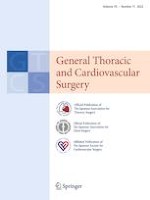Erschienen in:

02.07.2022 | How to Do It
Novel technique in frozen elephant trunk positioning method using the ostium of the coronary artery on transesophageal echocardiography as an index
verfasst von:
Eijiro Nogami, Kojiro Furukawa, Hideyuki Fumoto, Keiji Kamohara
Erschienen in:
General Thoracic and Cardiovascular Surgery
|
Ausgabe 11/2022
Einloggen, um Zugang zu erhalten
Abstract
The frozen elephant trunk (FET) technique is useful in the single-stage treatment of aortic arch aneurysms. Since there is no established implantation method for evaluating the distal end of the FET during surgery, we propose the FET positioning method using the ostium of the coronary artery on transesophageal echocardiography (TEE) as an index. We performed 11 total arch replacement operations using an FET for aortic arch aneurysm. The planned position of the FET was determined by computed tomography (CT), and the distance to the ostium of the coronary artery was measured. Intraoperatively, using TEE as a guide, the FET was implanted using our method. Postoperative CT was evaluated the distance from the planned FET position, and the average and median difference was only 0.96 cm and 0.6 cm, respectively. TEE-guided FET deployment using the coronary artery ostium as an index is a simple and reproducible technique.











